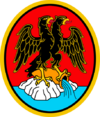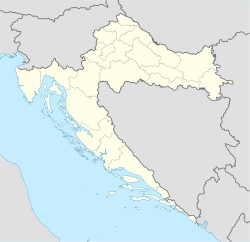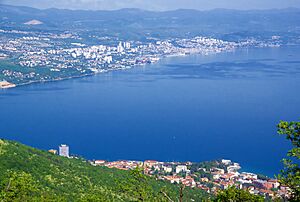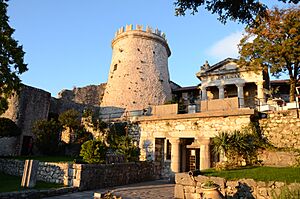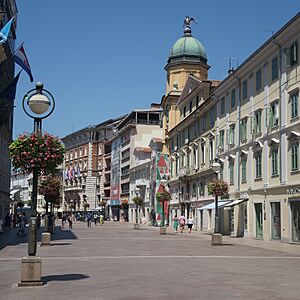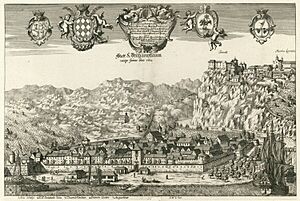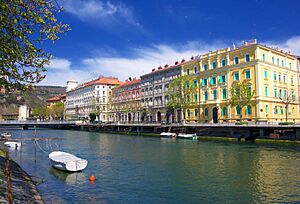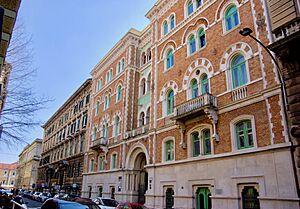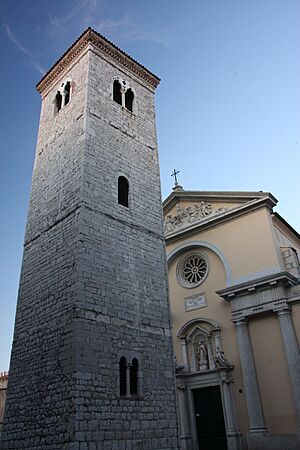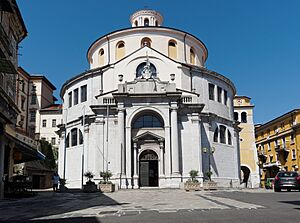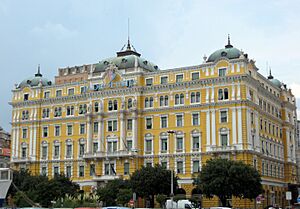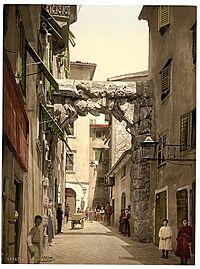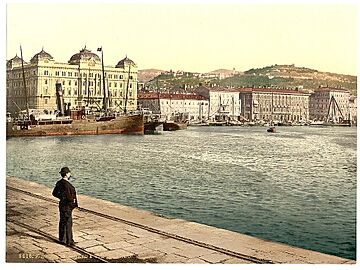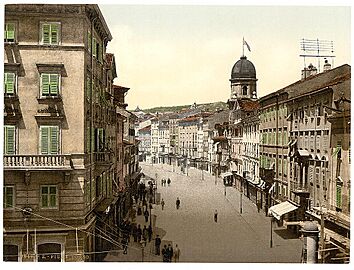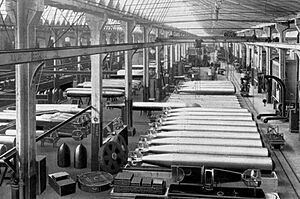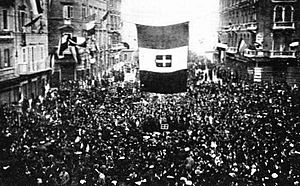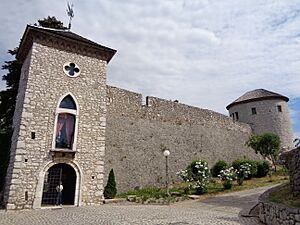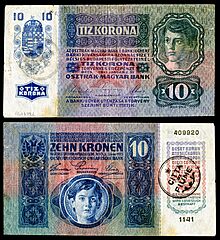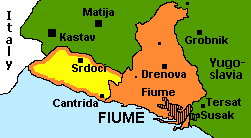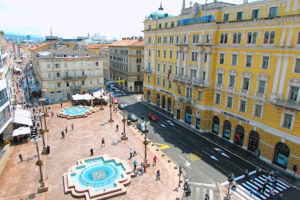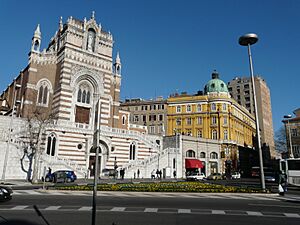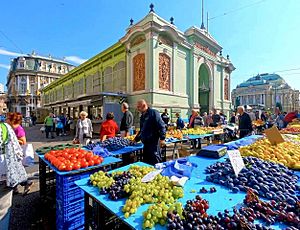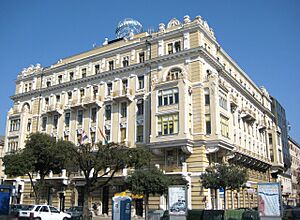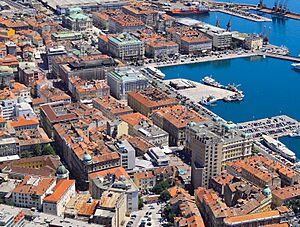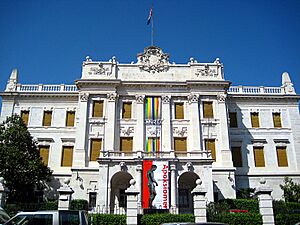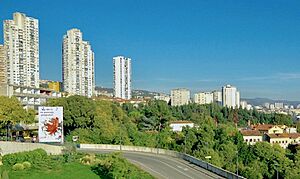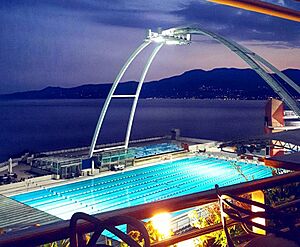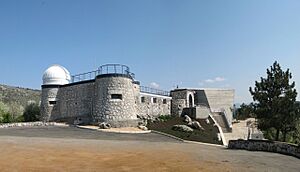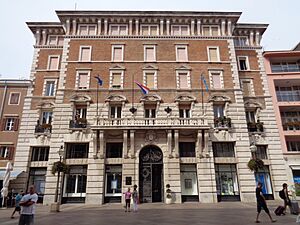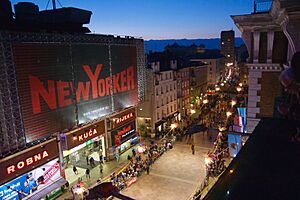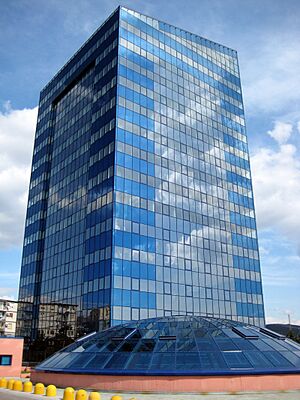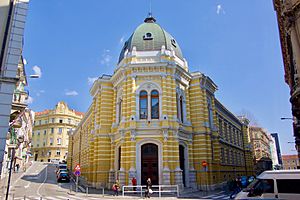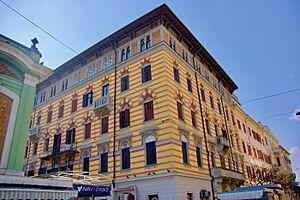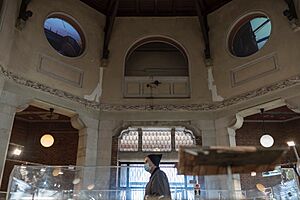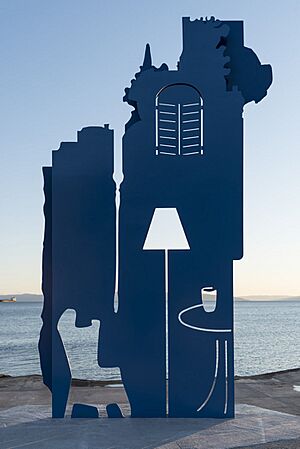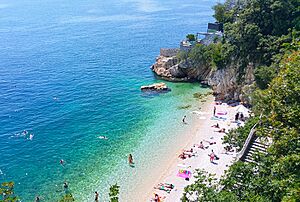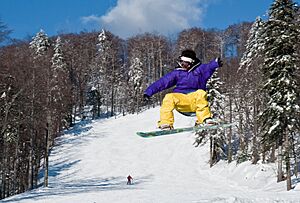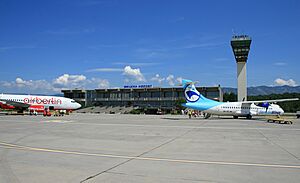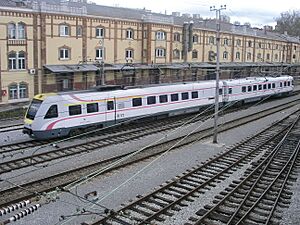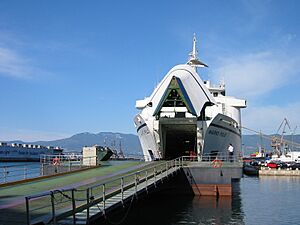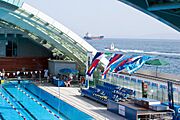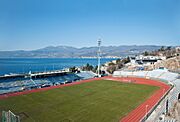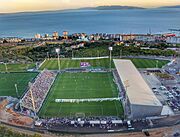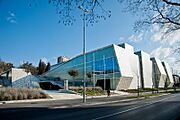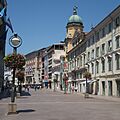Rijeka facts for kids
Quick facts for kids
Rijeka
Reka / Rika (Chakavian)
Fiume (Fiuman) Fiume (Italian)
|
|||
|---|---|---|---|
| City of Rijeka Grad Rijeka |
|||
|
Riva Waterfront
Palace Modello
Trsat Castle
HNK Zajc
Rijeka Cathedral
Italian Secondary School
|
|||
|
|||
| Country | |||
| County | Primorje-Gorski Kotar | ||
| Area | |||
| • City | 43.4 km2 (16.8 sq mi) | ||
| • Urban | 43.4 km2 (16.8 sq mi) | ||
| • Metro | 3,200 km2 (1,200 sq mi) | ||
| Elevation | 0–499 m (0–1,637 ft) | ||
| Population
(2021)
|
|||
| • City | 107,964 | ||
| • Density | 2,487.6/km2 (6,443/sq mi) | ||
| • Urban | 107,964 | ||
| • Urban density | 2,487.6/km2 (6,443/sq mi) | ||
| Time zone | UTC+1 (CET) | ||
| • Summer (DST) | UTC+2 (CEST) | ||
| Postal code |
51000
|
||
| Area code(s) | 051 | ||
| Vehicle registration | RI | ||
| Patron saints | St. Vitus | ||
Rijeka is a major port city in Croatia. It is the third-largest city in the country, after Zagreb and Split. Rijeka is located on Kvarner Bay, which is part of the Adriatic Sea. In 2021, about 108,000 people lived there.
Because of its great location and deep-water port, Rijeka has been very important throughout history. Many different groups, like the Holy Roman Empire, Italy, and Croatia, have wanted to control it. This meant the city's rulers and people changed many times over the centuries. Today, most of its citizens are Croats, with smaller groups of Serbs, Bosniaks, and Italians.
Rijeka is the main city and capital of the Primorje-Gorski Kotar County. Its economy relies a lot on shipbuilding and sea transport. The city is also home to the Croatian National Theatre Ivan pl. Zajc, which opened in 1765. The University of Rijeka was founded in 1973, but its roots go back to a Jesuit school in 1632.
Besides Croatian and Italian, people in Rijeka also speak a special dialect of the Venetian language called Fiuman. About 20,000 people, including Italians, Croats, and other groups, speak it. In the past, Fiuman was like a common language for the many different people living in this port city. Some people in the city's suburbs still speak Chakavian, a Croatian dialect.
In 2016, Rijeka was chosen to be the European Capital of Culture for 2020, along with Galway, Ireland.
Contents
What's in a Name?
Historically, Rijeka had different names. In Latin, it was called Tharsatica, Vitopolis (meaning 'City of Saint Vitus'), or Flumen (meaning 'River'). Today, it is called Rijeka in Croatian and Reka in Slovene. In local Chakavian dialects, it's Reka or Rika. In Italian and Fiuman Venetian, it's called Fiume. All these names mean 'river' in their languages. The old German name was Sankt Veit am Flaum, meaning 'St. Vitus on the Flaum', which refers to the river.
Rijeka's Location and Surroundings
Rijeka is in western Croatia, about 131 kilometers (81 miles) southwest of the capital, Zagreb. It sits on the coast of Kvarner Gulf, in the northern part of the Adriatic Sea. Rijeka is quite close to other big European cities like Milan, Budapest, Munich, Vienna, and Belgrade. Nearby cities include Trieste, Venice, and Ljubljana.
The Bay of Rijeka is very deep, about 50 meters (164 feet). This allows large ships to enter the port easily. The city is at the mouth of the Rječina river. Mountains surround Rijeka on three sides. To the west is the Učka range, which is 1,396 meters (4,580 feet) high. To the north, you'll find the Snežnik plateau and the Risnjak massif, home to a national park. To the east, there is the Velika Kapela range.
Because of these mountains, Rijeka mostly grew along the coast. Two important routes start here, connecting the city to inland areas. One goes northeast towards the Pannonian Basin, making Rijeka a natural harbor for places like Hungary. The other route goes northwest through the Postojna Gate, linking Rijeka to Slovenia and Austria. A third route runs along the coast, connecting Rijeka to Trieste and northern Italy.
Rijeka Through Time
Historical affiliations
![]() Kingdom of Croatia pre-1102. Kingdom of Croatia-Kingdom of Hungary:1102–1466
Kingdom of Croatia pre-1102. Kingdom of Croatia-Kingdom of Hungary:1102–1466
![]() Holy Roman Empire (Habsburg monarchy), 1466–1809
Holy Roman Empire (Habsburg monarchy), 1466–1809
![]() First French Empire, 1809–1814
First French Empire, 1809–1814
![]() Austrian Empire, 1814–1867
Austrian Empire, 1814–1867
![]() Austria-Hungary (
Austria-Hungary (![]() Transleithania), 1867–1918
Transleithania), 1867–1918
![]() Italian Regency of Carnaro, 1919–1920
Italian Regency of Carnaro, 1919–1920
![]() Free State of Fiume, 1920–1924
Free State of Fiume, 1920–1924
![]() Kingdom of Italy, 1924–1943
Kingdom of Italy, 1924–1943
![]() OZAK, 1943–1945
OZAK, 1943–1945
![]() Yugoslavia (
Yugoslavia (![]() SR Croatia), 1945–1991
SR Croatia), 1945–1991
![]() Croatia, 1991–present
Croatia, 1991–present
Ancient and Medieval History
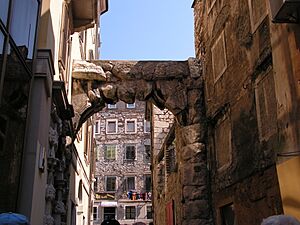
People lived in this area even in the Stone Age. The first known settlements were Celtic Tharsatica (now Trsat, part of Rijeka) on a hill, and a group of sailors called the Liburni in the harbor below. The city was first mentioned in the 1st century AD as Tarsatica. Around 150 AD, the Greek geographer Ptolemy also wrote about it.
During the time of Augustus, the Romans rebuilt Tarsatica as a town called Flumen. It was located on the right bank of the small Rječina river. This town was part of the Roman Province of Dalmatia until the 6th century. During this time, the city was part of a defense system against invaders. You can still see parts of these old walls today.
After the 4th century, Rijeka was named after St. Vitus, its patron saint. From the 5th century onwards, different groups ruled the town, including the Ostrogoths, Byzantines, Lombards, and Avars. In 452, the city was burned down by Attila the Hun's troops.
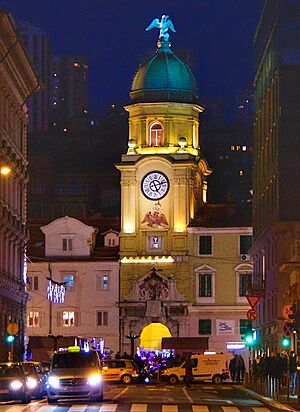
Croats settled in the city starting in the 7th century. They gave it the Croatian name, Rika svetoga Vida ("the river of Saint Vitus"). At that time, Rijeka was a walled fortress town with a castle at its highest point.
In 799, Charlemagne's Frankish troops attacked Rijeka. They were first pushed back, and their commander was killed. But the Frankish forces eventually took over and destroyed the castle. Around 925, the town became part of the Kingdom of Croatia. From 1102, it was connected to Hungary.
In 1288, the people of Rijeka signed the Law codex of Vinodol, one of Europe's oldest law books. From about 1300 to 1466, different noble families ruled Rijeka. In 1466, Rijeka was sold to the Habsburg emperor Frederick III. It stayed under Austrian Habsburg rule for over 450 years. The only break was a short period of French rule between 1809 and 1813.
Rijeka Under Habsburg Rule
The Republic of Venice saw Austria's presence on the Adriatic Sea as a threat. During the War of the League of Cambrai, the Venetians attacked and damaged the city in 1508 and 1509. However, Rijeka recovered and remained under Austrian rule. Because it fought bravely against the Venetians, Emperor Maximilian I gave it the title of "most loyal city" in 1515. He also gave it special trading rights.
Although Ottoman forces attacked the town several times, they never took it over. From the 16th century, Rijeka began to look like it does today, with Renaissance and Baroque buildings. In 1719, Emperor Charles VI made the Port of Rijeka a free port. This meant ships could trade there without paying many taxes.
On November 28, 1750, a big earthquake hit Rijeka. The city was so damaged that it had to be almost completely rebuilt. In 1753, Empress Maria Theresa approved money to rebuild Rijeka as a "new city." The rebuilt Rijeka changed from a small medieval town into a larger trading and shipping city, focused on its port.
In 1779, Maria Theresa ordered the city to be joined to the Kingdom of Hungary. It was governed directly from Budapest as a special area, serving as Hungary's only international port. From 1804, Rijeka was part of the Austrian Empire.
During the Napoleonic Wars, the French Empire briefly took over Rijeka. They included it in the Illyrian Provinces. During French rule (1809-1813), the important Louisiana road was finished. This road was the shortest way from Rijeka to the inland city of Karlovac. It greatly helped Rijeka's port grow.
In 1813, the French rule ended. Rijeka was first attacked by the Royal Navy and then taken back by the Austrians. A local legend says that a young lady named Karolina Belinić saved the city from more bombing. She supposedly convinced the English fleet commander to stop attacking. Karolina became a folk hero, "Karolina Riječka," and is still celebrated today.
In the early 19th century, Andrija Ljudevit Adamić was a key leader in the city's economy and culture. Rijeka also had an important naval base. In the mid-19th century, it became the site of the Austro-Hungarian Naval Academy, where naval officers were trained.
Rijeka Under the Hungarian Crown
During the Hungarian Revolution of 1848, when Hungary tried to become independent from Austria, Croatian troops captured Rijeka. These troops were loyal to Austria and led by Ban Josip Jelačić. The city was then joined directly to Croatia, but it still kept some self-rule.
Giovanni de Ciotta was mayor from 1872 to 1896. Under his leadership, the city grew a lot. The port was greatly improved, helped by more international trade and the city's connection to the Austro-Hungarian railway network in 1873. New industries and businesses started, like the Royal Hungarian Sea Navigation Company "Adria" and the Smith and Meynier paper mill. This paper mill used the first steam engine in Southeast Europe and made cigarette paper sold worldwide.
The late 19th and early 20th centuries (until World War I) were a time of great success for Rijeka. The city saw fast economic growth and new technologies. Many people described Rijeka as a rich, welcoming town with a good quality of life. Industrial growth included Europe's first large-scale oil refinery in 1882. The world's first torpedo factory opened in 1866. This happened after Robert Whitehead, a manager at a local engineering company, successfully tested the first torpedo.
Other businesses that grew or started included a rice factory, a wood company, a wheat mill, shipbuilding companies, a chocolate factory, and a tobacco factory. By the early 1900s, more than half of Croatia's industrial production was in Rijeka.
The Austro-Hungarian Marine Academy in Rijeka became a leader in high-speed photography. In 1886, physicist Peter Salcher took the first photo of a bullet flying faster than sound. This technique was later used by Ernst Mach to study supersonic motion.
Rijeka's port grew enormously with Hungarian investments. It became the main sea outlet for Hungary and the eastern part of the Austro-Hungarian Empire. By 1913–14, Rijeka's port was the tenth busiest in Europe. The city's population also grew quickly, from 21,000 in 1880 to 50,000 in 1910. Many important public buildings were built then, like the Governor's Palace.
At the last Austro-Hungarian census in 1910, Rijeka had 49,806 people. The main languages spoken were:
| Languages in 1911 | 49,806 inhabitants | (100%) |
| Italian | 23,283 | (46.9%) |
| Croatian | 15,731 | (31.7%) |
| Slovenian | 3,937 | (7.9%) |
| Hungarian | 3,619 | (7.3%) |
| German | 2,476 | (5.0%) |
By religion, most people were Catholics (45,130). There were also 1,696 Jewish people, who built a large synagogue in 1907.
- Rijeka in early 20th century
Rijeka During World War I
World War I ended Rijeka's "golden era" of peace and growth. The city never fully recovered its previous prosperity. At first, things seemed normal because the city was far from the fighting. However, more and more men were called to join the army and navy. The city's war industries worked hard, especially for the Austro-Hungarian navy. The Ganz-Danubius shipyard built many warships and submarines. Rijeka was also the main place for making torpedoes.
Things changed when Italy declared war on Austria-Hungary in May 1915. This created a war zone only 90 km (56 miles) from the city. Many Italians in Rijeka were seen as disloyal and sent to camps in Hungary, where some died. The torpedo factory was attacked by an Italian airship in 1915. Because of this, most torpedo production moved to Austria. The city was attacked by Italian planes again in 1916. The Naval Academy became a war hospital.
As the war continued, Rijeka's economy and people's living standards quickly worsened. Port traffic collapsed because of a sea blockade. Many factories closed or produced less due to lack of workers or materials. Food and other basic needs became scarce. Crime also increased. On October 23, 1918, Croatian troops in Rijeka rebelled and took control of the city for a short time. The Austro-Hungarian empire broke apart a few weeks later, on November 12, 1918. This started a long period of uncertainty for Rijeka.
The "Fiume Question" and Disputes
After Austria-Hungary broke up in October 1918, both Croatian-Serbian and Italian groups claimed control of Rijeka. Both Italy and the new Kingdom of the Serbs, Croats and Slovenes (later Yugoslavia) wanted the city. They based their claims on the ethnic groups living there.
After a short military occupation by the Kingdom of Serbs, Croats and Slovenes, international troops from Britain, Italy, France, and America entered the city in November 1918. Rijeka's future became a big problem at the Paris Peace Conference in 1919. US President Wilson even suggested making Rijeka a free city and the headquarters of the new League of Nations.
The main issue was that Rijeka was not given to either Italy or Croatia (Yugoslavia) in the Treaty of London. It was supposed to remain with Austria-Hungary. But when the empire fell apart, the city's status was unclear. Italy claimed it because Italians were the largest group in the city (46.9%). Croats made up most of the rest and were a majority in the surrounding area. Many people in Rijeka wanted the city to be independent and multicultural.
The Regency of Carnaro
On September 10, 1919, the Treaty of Saint-Germain was signed, ending the Austro-Hungarian monarchy. Two days later, an Italian nationalist group led by the poet Gabriele D'Annunzio took over the city. Since the Italian government did not want to annex Fiume, D'Annunzio created an independent state called the Italian Regency of Carnaro. This was a unique social experiment that attracted many international thinkers.
D'Annunzio and his group tried to create a "League of Fiume." This organization was against the League of Nations and aimed to help all oppressed nations. It was the first state in the world to recognize Soviet Russia. However, it did not get enough outside support.
Giovanni Giolitti became Italy's Prime Minister again in June 1920. This meant the government took a tougher stance against D'Annunzio. On November 12, Italy and Yugoslavia signed the Treaty of Rapallo. This treaty planned for Fiume to become an independent state, the Free State of Fiume. D'Annunzio responded by declaring war on Italy. Italian forces then bombed the city, leading to his surrender after five days of fighting (known as Bloody Christmas). Italian troops freed the city from D'Annunzio's forces in late December 1920. After a world war and two more years of economic problems, the city's economy was collapsing, and its people were exhausted.
The Free State of Fiume
In an election on April 24, 1921, the people of Fiume voted for an independent state. They wanted a Fiuman-Italian-Yugoslav group to own the port. This was a big win for the independent candidates. Fiume then became a member of the League of Nations. Riccardo Zanella was elected as Rijeka's first president, and major world powers recognized this.
Despite these positive steps, there were still problems within the city. A brief takeover by Italian nationalists ended with Italian intervention. Another short peace was broken by a Fascist takeover in March 1922. Seven months later, the Kingdom of Italy itself came under Fascist rule. The Italian Fascist Party strongly supported joining Fiume to Italy. The Free State of Fiume officially became the first country to fall victim to fascist expansion.
Rijeka as Part of the Kingdom of Italy
The diplomatic problems ended with the Treaty of Rome on January 27, 1924. Italy and Yugoslavia agreed to divide the small state. Most of the old territory became part of Italy. A few Croatian/Slovenian-speaking villages north of the city went to Yugoslavia. The change happened on March 16, 1924. This began about twenty years of Italian rule for the city itself. During this time, the Croatian minority faced discrimination.
The city became the capital of the new Province of Fiume. In this period, Fiume lost its connection to its economic hinterland. It became a border town, less important for Italy. However, it kept its free port status and received many economic benefits and money from the Italian government. This included special tax treatment and continuous investments. The city became prosperous again and was richer than the surrounding Yugoslav lands. But its economic and population growth slowed compared to the earlier Austro-Hungarian period.
World War II and German Occupation

At the start of World War II, Rijeka was in a difficult spot. Most people in the city were Italian, followed by Croatians. But the areas around the city and the town of Sušak (now part of Rijeka) were almost entirely Croatian and part of Yugoslavia, a potential enemy. When the Axis powers invaded Yugoslavia in April 1941, the Croatian areas around Rijeka were taken over by the Italian military. This led to intense fighting that lasted until the end of the war.
Partisan fighters attacked Italian and later German authorities. In response, the Italian and German military carried out harsh actions. For example, on July 14, 1942, Italian forces killed 100 men from the village of Podhum and sent 800 others to concentration camps. On April 30, 1944, German troops killed 263 civilians in the village of Lipa.
The German and Italian occupiers also sent about 80% of the city's 500 Jewish residents to Auschwitz. More Jewish people from Rijeka were killed in the Holocaust than from any other city in Italian territory.
Because of its factories (oil refinery, torpedo factory, shipyards) and port, Rijeka was bombed more than 30 times by British and American planes. These attacks caused widespread destruction and killed hundreds of civilians. Some of the heaviest bombings happened in January and November 1944, and February 1945.
The Rijeka area was heavily fortified even before World War II. These defenses marked the border between Italy and Yugoslavia. As Yugoslav troops approached the city in April 1945, one of the fiercest battles in Europe took place. About 27,000 German and Italian troops fought hard from behind these defenses. They caused many casualties among the attacking Partisans. The Yugoslav commanders pushed their troops hard to capture the city quickly. They feared that English forces might land and stop their advance towards Trieste.
After a very bloody battle, the Germans were forced to retreat. Before leaving, they destroyed much of the harbor and other important buildings. However, the Germans could not break out of the encirclement northwest of the city. Of the approximately 27,000 German and other troops retreating, 11,000 were killed or executed after surrendering. The remaining 16,000 were taken prisoner. Yugoslav troops entered Rijeka on May 3, 1945. The city was severely damaged in the war. Its economy was almost completely destroyed. More than half of the city's buildings were either destroyed or damaged.
After World War II
Rijeka's future was again decided by a mix of force and diplomacy. Even though the local government in exile asked for the city-state's independence, and Yugoslav authorities initially promised independence or self-rule, the city was taken over by Yugoslavia. It became part of the federal state of Croatia. Any disagreement among the people was suppressed in the year after the war.
The situation created by the Yugoslav forces was made official by the 1947 Paris peace treaty. After this, about 58,000 of the city's 66,000 residents were forced to leave or faced harsh treatment by the new Yugoslav Communist government. These people became known as esuli (exiled ones). The Yugoslav Communist Party wanted to change the local population. They made it difficult for the Italian-speaking people to stay. Many Italians left Rijeka to avoid further problems.
One notable group affected were the Autonomists. They had helped the Yugoslav partisans fight against Fascist and Nazi occupation. Despite promises of self-rule for the city, they were killed by the Yugoslav secret police.
In the years that followed, the Yugoslav authorities combined the towns of Fiume and Sušak. After 1954, less than one-third of the original population remained. The old Fiume municipality lost over 85% of its people. The Yugoslav government wanted a more loyal population in Rijeka. In 1954, during the Trieste crisis, local Communist Party members destroyed Italian and bilingual signs in the city. Bilingualism was mostly removed, except in a few schools and the Italian Community building. After the war, many ethnic Italians from Rijeka moved to Italy.
The city was then resettled by people from other parts of Yugoslavia. This changed Rijeka's population and languages again. These years also saw a period of rebuilding and new industrial growth after the war's destruction. During the Yugoslav Communist rule (1950s-1980s), Rijeka became the main port of Yugoslavia. It grew again in population and economy. It benefited from its re-established connections to inland areas and the rebuilding of its industries and port. Rijeka soon became the second richest area in Yugoslavia by GDP per person. However, many of these industries, based on a planned economy, could not survive when the economy changed to a market system in the early 1990s.
When Yugoslavia broke up in 1991, Croatia became independent. Rijeka became part of the new Croatia during the Croatian War of Independence. Since then, the city's economy has struggled, and its population has decreased. Many large industries and employers, like the Jugolinija shipping company and the torpedo factory, closed down. Others, like the 3. Maj shipyard, have faced difficulties. The number of people working in manufacturing dropped sharply. Economic problems and corruption during Croatia's change from socialism to capitalism, along with years of war economy, played a big role in Rijeka's economic decline in the 1990s and early 2000s. The city is still trying to shift its economy from manufacturing to services and tourism.
In 2018, it was announced that new Croatian-Italian bilingual signs would be put back in the Fiume part of the city. This happened 65 years after Italian was removed as an official language. In 2020, Rijeka was named the European Capital of Culture alongside Galway. It had a program with over 600 cultural and social events.
Rijeka's International Carnival
The Rijeka Carnival (Croatian: Riječki karneval) happens every year before Lent, usually between late January and early March. It started in 1982 and is now the biggest carnival in Croatia. Many events take place before the main carnival. First, the mayor of Rijeka gives a special key to Meštar Toni, who becomes the "maestro" of the carnival. He acts as the city's mayor during this time. On the same day, a carnival queen is chosen. The Queen and Meštar Toni attend events in other towns around Rijeka.
Every year, a Carnival charity ball is held at the Governor's palace. Important people from politics, sports, media, and many ambassadors attend.
The weekend before the main event, two other events are held. One is the Rally Paris–Bakar, named after the famous Dakar Rally. It starts in a part of Rijeka called Paris and ends in the city of Bakar, about 20 km (12 miles) southeast. All participants wear masks, and their cars are often old and modified. The other event is the children's carnival, which takes place on Rijeka's main street, Korzo. Groups from kindergartens and elementary schools, including those from other parts of Croatia and nearby countries, take part.
In 1982, only three masked groups were on Korzo. In recent years, the international carnival has grown to include about 15,000 participants from all over the world. They are organized into over 200 carnival groups, and more than 100,000 people come to watch.
Who Lives in Rijeka?
| Historical population | ||
|---|---|---|
| Year | Pop. | ±% |
| 1880 | 37,904 | — |
| 1890 | 48,959 | +29.2% |
| 1900 | 61,419 | +25.4% |
| 1910 | 76,042 | +23.8% |
| 1921 | 61,157 | −19.6% |
| 1931 | 72,111 | +17.9% |
| 1948 | 67,088 | −7.0% |
| 1953 | 73,718 | +9.9% |
| 1961 | 98,759 | +34.0% |
| 1971 | 129,173 | +30.8% |
| 1981 | 158,226 | +22.5% |
| 1991 | 165,904 | +4.9% |
| 2001 | 144,043 | −13.2% |
| 2011 | 128,624 | −10.7% |
| 2021 | 107,964 | −16.1% |
| Source: Naselja i stanovništvo Republike Hrvatske 1857–2021, DZS, Zagreb | ||
In the 2021 census, the city of Rijeka had a population of 107,964 people. Here's a breakdown of the main groups:
| Croats | 92,075 | (85.28%) |
| Serbs | 5,537 | (5.13%) |
| Bosniaks | 1,696 | (1.57%) |
| Italians | 1,569 | (1.45%) |
Other groups, like Slovenes and Hungarians, each made up less than 1% of the population.
The Croatian census counts two settlements within the City of Rijeka: the city itself and Sveti Kuzam. In 2014, the Rijeka city council decided to combine Sveti Kuzam with the settlement of Rijeka.
Here are tables showing the population of the city, the former wider municipality, the urban area, and the metropolitan area:
| Year | City proper | Ex-municipality | Urban | Metro |
|---|---|---|---|---|
| 1981 | 158,226 | 193,044 | 222,318 | 251,768 |
| 1991 | 165,904 | 206,229 | 236,028 | 268,016 |
| 2001 | 144,043 | 191,647 | 220,538 | 252,933 |
| 2011 | 128,624 | 185,125 | 213,666 | 245,054 |
| 2021 | 107,964 | 165,008 | 191,293 | 219,325 |
| Population | Area (km2) | Density | |
| City proper | 107,964 | 44 | 2,469 |
| Ex-municipality | 56,386 | 473 | 119 |
| Subtotal | 165,008 | 517 | 319 |
| Urban agglomeration | 26,285 | 308 | 85 |
| Subtotal | 191,293 | 825 | 232 |
| Metro area | 28,032 | 840 | 33 |
| Total | 219,325 | 1,665 | 132 |
- Ex-municipality: This includes other towns and municipalities that were once part of a larger official group of settlements. This group was dissolved in 1995.
- Urban agglomeration: This is the area directly next to the city. It includes the ex-municipality and other towns that form a connected urban area.
- Metro area: This is a wider area of influence. It includes towns and municipalities that are connected to Rijeka, even if they are further away.
| population |
18597
|
23880
|
27904
|
38959
|
51419
|
66042
|
61157
|
72111
|
67088
|
73718
|
98759
|
129173
|
158226
|
165904
|
144043
|
128624
|
107964
|
| 1857 | 1869 | 1880 | 1890 | 1900 | 1910 | 1921 | 1931 | 1948 | 1953 | 1961 | 1971 | 1981 | 1991 | 2001 | 2011 | 2021 |
Panoramas
Main Sights and Attractions
- Torpedo Factory: This is where the first European self-propelled torpedoes were invented by Giovanni Luppis. You can still see parts of the factory, including a well-preserved ramp used for testing torpedoes. The first torpedo was tested here in 1866.
- Croatian National Theatre Building: Opened in October 1885, this grand theater features works by famous artists. These include the Venetian sculptor August Benvenuti and ceiling artists Franz Matsch, Ernst, and Gustav Klimt.
- Sanctuary of Our Lady of Trsat: Built on Trsat hill, this sanctuary is a guardian for travelers, especially sailors. They bring offerings here for protection or help. It has a Gothic sculpture of the Madonna of Slunj and paintings by C. Tasce.
- Trsat Castle: This 13th-century fortress offers amazing views. From its walls, you can look down the Rječina river valley to the docks and the Kvarner Gulf.
- Petar Kružić Staircase: This stairway connects downtown Rijeka to Trsat. It has 561 stone steps and was built for pilgrims visiting the Sanctuary of Our Lady of Trsat.
- Old Gate or Roman Arch: People first thought this was a Roman Triumphal Arch. Later, it was found to be a gate to the pretorium, which was an army command center in ancient times.
- Rijeka Cathedral: This cathedral is dedicated to St. Vitus, the city's patron saint.
- Palace Modello: Designed by Buro Fellner & Helmer, this beautiful palace was built in 1885.
- Stadion Kantrida: This football stadium was listed by CNN in 2011 as one of the world's most iconic and unusual stadiums.
- Art Installation "Masters": This art piece is located under the high ceiling of Rijeka's fish market. It includes a video of a fishing trawler in the Kvarnerić waters and sounds of the sea. It honors the fishermen who bring fish to the market.
- Art Installation "Balthazartown Beach": This artwork is on Grčevo beach, also known as Pajol or Šestica. Students designed a steel sculpture that changes how you see the area. They also created 15 inscriptions on a concrete area that appear when wet. The art is inspired by Professor Balthazar, a famous animated series that used Rijeka as inspiration for Balthazartown.
Rijeka's Climate
Rijeka has a humid subtropical climate. This means it has warm summers and mild, rainy winters. The mountains rising steeply from the coast create amazing climate differences in a small area. You can enjoy beaches in the summer along the city's coastal areas. At the same time, the Platak ski resort is only about 10 km (6 miles) away. It offers alpine skiing and plenty of snow in winter, sometimes even until May. From the ski slopes, you can see the Kvarner Bay and its islands.
Unlike typical Mediterranean places, Rijeka usually does not have dry summers. Snow is rare, usually falling about three days a year in small amounts. Temperatures reach 30°C (86°F) or higher about 20 days a year. On only one day a year, the temperature might not go above 0°C (32°F). Fog appears about four days a year, mostly in winter. The climate also has frequent rainfall. Cold winds called bora are common in winter.
| Climate data for Rijeka (1971–2000, extremes 1948–present) | |||||||||||||
|---|---|---|---|---|---|---|---|---|---|---|---|---|---|
| Month | Jan | Feb | Mar | Apr | May | Jun | Jul | Aug | Sep | Oct | Nov | Dec | Year |
| Record high °C (°F) | 20.0 (68.0) |
21.4 (70.5) |
24.0 (75.2) |
29.0 (84.2) |
33.7 (92.7) |
36.8 (98.2) |
40.0 (104.0) |
39.2 (102.6) |
34.8 (94.6) |
28.8 (83.8) |
25.5 (77.9) |
20.4 (68.7) |
40.0 (104.0) |
| Mean daily maximum °C (°F) | 9.1 (48.4) |
9.9 (49.8) |
12.6 (54.7) |
15.9 (60.6) |
21.1 (70.0) |
24.6 (76.3) |
27.9 (82.2) |
28.1 (82.6) |
23.5 (74.3) |
18.5 (65.3) |
13.2 (55.8) |
10.1 (50.2) |
17.9 (64.2) |
| Daily mean °C (°F) | 5.8 (42.4) |
6.3 (43.3) |
8.8 (47.8) |
12.0 (53.6) |
16.8 (62.2) |
20.3 (68.5) |
23.1 (73.6) |
23.1 (73.6) |
18.8 (65.8) |
14.2 (57.6) |
9.6 (49.3) |
6.8 (44.2) |
13.8 (56.8) |
| Mean daily minimum °C (°F) | 2.9 (37.2) |
3.2 (37.8) |
5.5 (41.9) |
8.4 (47.1) |
12.8 (55.0) |
16.0 (60.8) |
18.6 (65.5) |
18.6 (65.5) |
14.9 (58.8) |
10.9 (51.6) |
6.6 (43.9) |
4.0 (39.2) |
10.2 (50.4) |
| Record low °C (°F) | −11.4 (11.5) |
−12.8 (9.0) |
−7.7 (18.1) |
−0.2 (31.6) |
2.1 (35.8) |
7.4 (45.3) |
10.4 (50.7) |
9.1 (48.4) |
4.8 (40.6) |
−1.2 (29.8) |
−4.5 (23.9) |
−8.9 (16.0) |
−12.8 (9.0) |
| Average precipitation mm (inches) | 128.7 (5.07) |
104.1 (4.10) |
113.0 (4.45) |
113.8 (4.48) |
103.3 (4.07) |
119.9 (4.72) |
70.1 (2.76) |
101.5 (4.00) |
156.5 (6.16) |
203.9 (8.03) |
181.9 (7.16) |
155.6 (6.13) |
1,552.4 (61.12) |
| Average precipitation days (≥ 0.1 mm) | 10.7 | 8.5 | 10.3 | 12.6 | 12.5 | 12.3 | 8.8 | 9.0 | 10.6 | 12.1 | 11.7 | 11.2 | 130.1 |
| Average snowy days (≥ 1.0 cm) | 0.8 | 0.3 | 0.2 | 0.0 | 0.0 | 0.0 | 0.0 | 0.0 | 0.0 | 0.0 | 0.0 | 0.1 | 1.4 |
| Average relative humidity (%) | 65.1 | 60.3 | 60.4 | 62.6 | 63.7 | 62.4 | 56.4 | 56.0 | 63.7 | 67.4 | 67.3 | 66.4 | 62.7 |
| Mean monthly sunshine hours | 111.6 | 135.6 | 155.0 | 171.0 | 232.5 | 249.0 | 297.6 | 279.0 | 201.0 | 161.2 | 111.0 | 99.2 | 2,203.7 |
| Mean daily daylight hours | 9.2 | 10.4 | 12 | 13.6 | 14.9 | 15.6 | 15.3 | 14 | 12.5 | 10.9 | 9.5 | 8.8 | 12.2 |
| Percent possible sunshine | 41 | 50 | 47 | 47 | 57 | 61 | 71 | 71 | 58 | 51 | 42 | 40 | 55 |
| Average ultraviolet index | 1 | 2 | 3 | 5 | 7 | 8 | 8 | 7 | 5 | 3 | 2 | 1 | 4 |
| Source 1: Croatian Meteorological and Hydrological Service | |||||||||||||
| Source 2: Weather Atlas(Daylight-UV) | |||||||||||||
| Climate data for Rijeka | |||||||||||||
|---|---|---|---|---|---|---|---|---|---|---|---|---|---|
| Month | Jan | Feb | Mar | Apr | May | Jun | Jul | Aug | Sep | Oct | Nov | Dec | Year |
| Average sea temperature °C (°F) | 11.4 (52.6) |
10.7 (51.2) |
11.3 (52.3) |
13.7 (56.6) |
18.0 (64.3) |
22.6 (72.7) |
24.8 (76.5) |
24.9 (76.8) |
23.4 (74.1) |
19.5 (67.1) |
16.8 (62.2) |
14.3 (57.7) |
17.6 (63.6) |
| Source: Weather Atlas | |||||||||||||
 |
75 km to Trieste | 114 km to Ljubljana | 167 km to Zagreb |  |
| 14 km to Opatija | 580 km to Belgrade | |||
| 106 km to Pula | 75 km to Cres | 35 km to Crikvenica |
Getting Around Rijeka
The Port of Rijeka is the largest port in Croatia. In 2017, it handled 12.6 million tonnes of cargo, mostly oil and petroleum products. The port also handled over 260,000 shipping containers. Records of a port in Rijeka go back to 1281. In 1719, it was made a free port. There are ferry connections from Rijeka to nearby islands and cities. However, there are no direct international passenger ship connections. Coastal lines go to Split and Dubrovnik twice a week.
It can be hard to reach Rijeka by air outside of the main tourist season. The city's international airport, Rijeka Airport, is on the nearby island of Krk. You can get there by bus from Rijeka city center or Opatija. The bus schedule matches flight arrival and departure times. In 2019, the airport handled over 200,000 passengers. It is mostly a charter airport, but some airlines offer scheduled flights, especially from Germany. Most of these flights operate only during the tourist season, from May to October. Other nearby airports include Pula, Trieste, Ljubljana, Zagreb, and Venice.
Rijeka has good road connections to other parts of Croatia and neighboring countries. The A6 motorway connects Rijeka to Zagreb. The A7 motorway, finished in 2004, links Rijeka with Ljubljana, Slovenia, and Trieste, Italy. The A7 also acts as a bypass around Rijeka. It helps people get to the A8 motorway and the Istrian Y network, which connects Rijeka with Istria.
Rijeka is part of the Croatian railway network. It also has international rail lines. An electric railway connects Rijeka to Zagreb and further to Hungary. Rijeka is also connected to Trieste and Ljubljana by another electric line. There are direct train connections to cities like Prague, Munich, and Salzburg. Plans include building a new high-speed railway between Rijeka and Budapest.
Bus Connections
Rijeka Bus Station has regular bus lines to all major Croatian cities. These include Zagreb, Osijek, Zadar, Split, and Dubrovnik. Buses also frequently go to Istria, the islands of Cres, Lošinj, Krk, Rab, and Pag, and towns around Crikvenica. For international travel, there are regular buses to Germany, Switzerland, Italy, Bosnia and Herzegovina, and Serbia.
KD Autotrolej d.o.o. is the company that runs public buses in Rijeka and its surrounding areas.
Sports in Rijeka
Organized sports in Rijeka began between 1885 and 1888. The Club Alpino Fiumano was founded in 1885. The Young American Cycle Club started in 1887. The Nautico Sport Club Quarnero began in 1888. Even earlier, in 1873, the first football match in Croatia was played in Rijeka. It was between the Hungarian Railways team and English engineers from the Torpedo Factory. The first football club in Fiume was called Fiumei Atletikai Club.
Today, HNK Rijeka is the city's main football team. They play in the Croatian Football League and won the Croatian championship in 2016–17. Until 2015, HNK Rijeka played at the famous Stadion Kantrida. While Kantrida is being rebuilt, they play at the new Stadion Rujevica. Another football club, HNK Orijent, is based in Sušak.
Other notable sports clubs in Rijeka include:
- RK Zamet and ŽRK Zamet (for handball)
- VK Primorje EB (for water polo)
- KK Kvarner (for basketball)
- ŽOK Rijeka (for women's volleyball)
Between 1969 and 1990, Rijeka hosted the Yugoslav motorcycle Grand Prix. This was part of the Grand Prix motorcycle racing series. Rijeka also hosted the 2008 European Short Course Swimming Championships. During this event, many new records were set at the Bazeni Kantrida (Kantrida Swimming Complex). Swimmers from 21 nations won medals, and athletes from 40 European countries participated.
Rijeka's Sister Cities
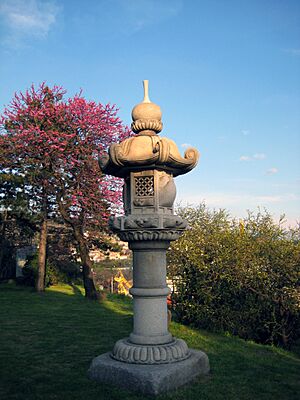
Rijeka has many twin towns and sister cities around the world:
Images for kids
See also
 In Spanish: Rijeka para niños
In Spanish: Rijeka para niños









